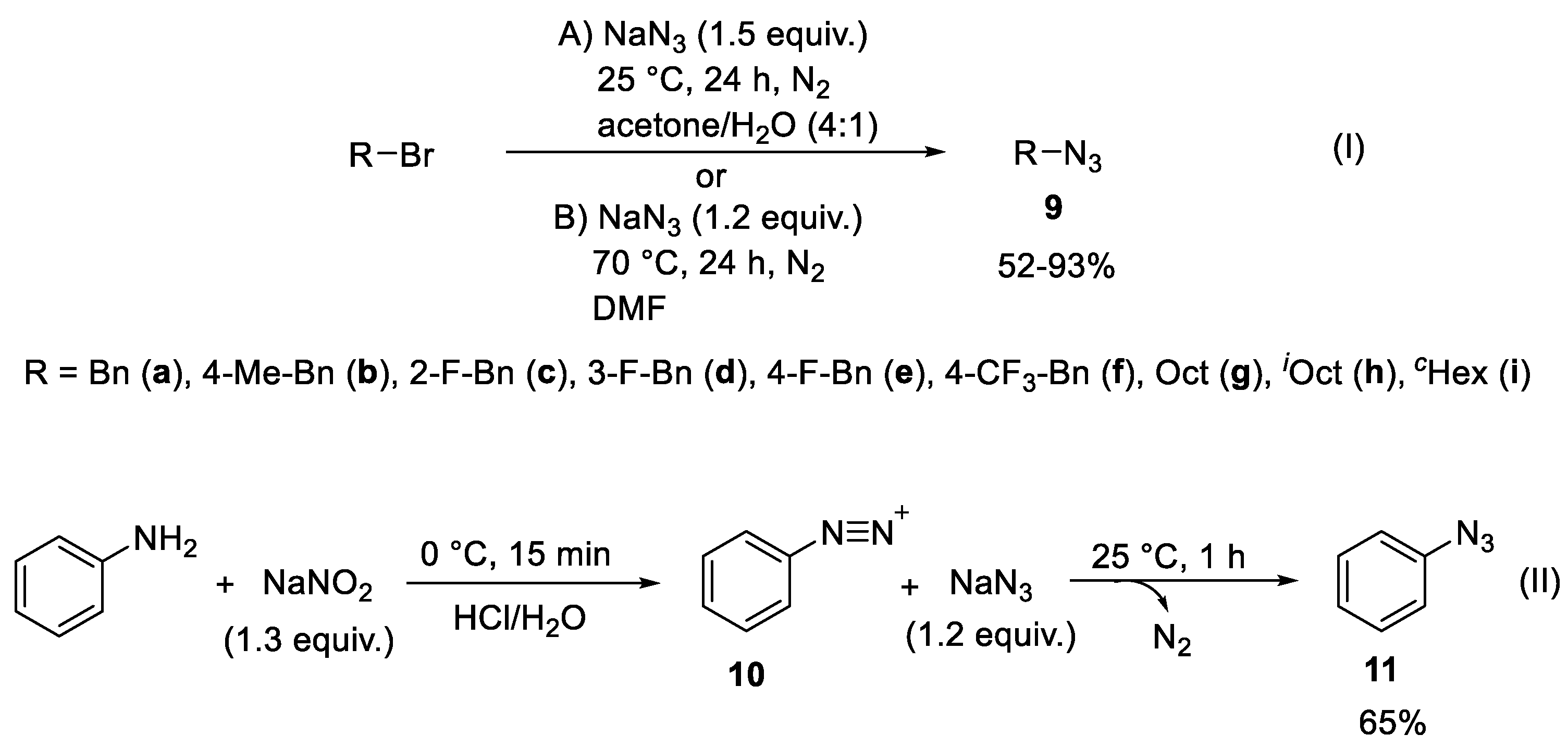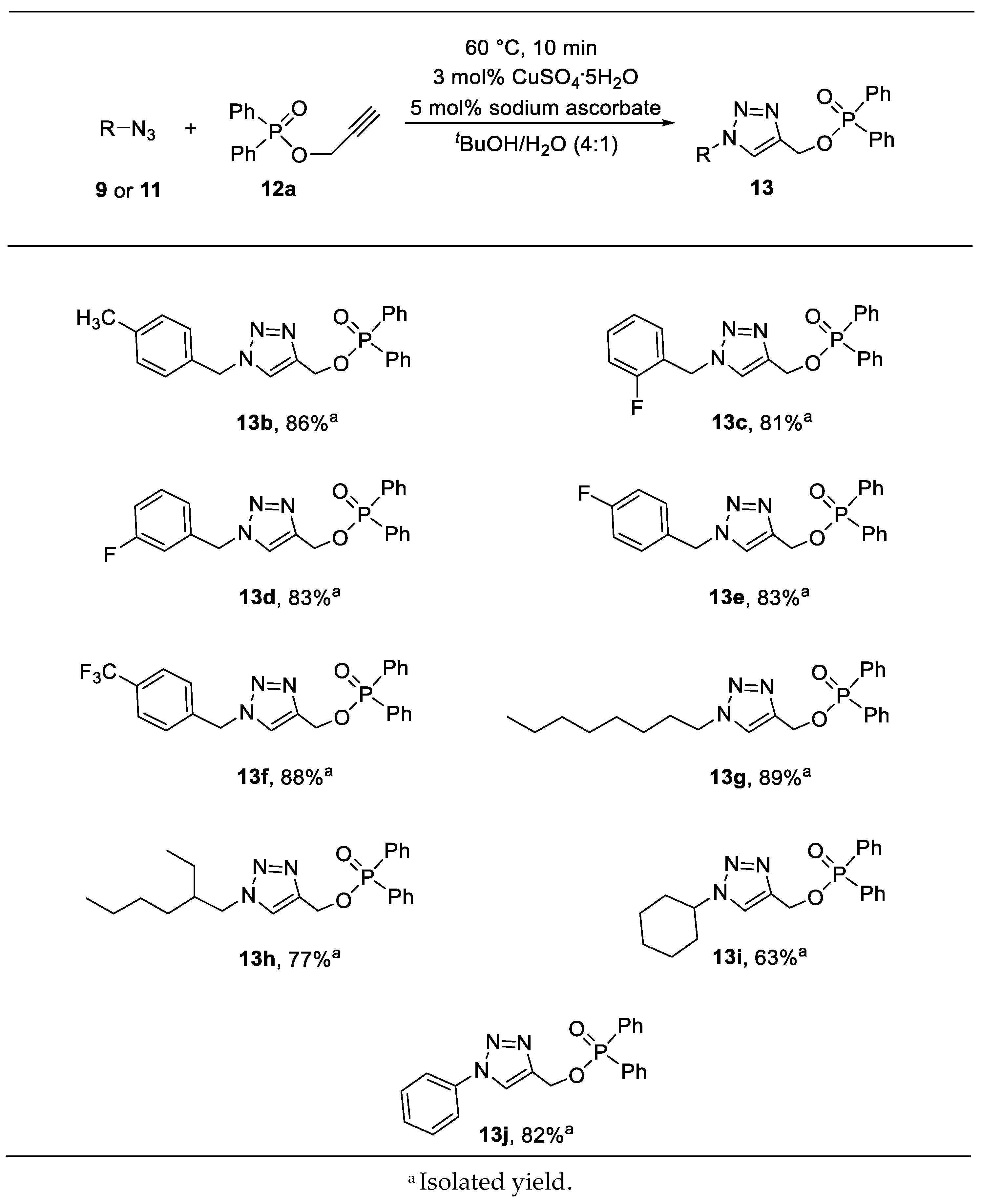Synthesis of (1,2,3-triazol-4-yl)methyl Phosphinates and (1,2,3-Triazol-4-yl)methyl Phosphates by Copper-Catalyzed Azide-Alkyne Cycloaddition
Abstract
:1. Introduction
2. Results and Discussion
3. Materials and Methods
3.1. General
3.2. General Procedure for the Synthesis of Benzyl Azides (Method A)
3.3. General Procedure for the Synthesis of Alkyl Azides (Method B)
3.4. General Procedure for the Synthesis of Phenyl Azide
3.5. General Procedure for the Synthesis of Prop-2-ynyl Diphenylphosphinate and Diethyl Prop-2-ynyl Phosphate
3.6. General Procedure for the Synthesis of (1H-1,2,3-Triazol-4-yl)methyl Phosphinates or Diethyl Phosphates
4. Conclusions
Supplementary Materials
Author Contributions
Funding
Conflicts of Interest
References
- Katritzky, A.R.; Rees, C.W.; Scriven, C.W.V. (Eds.) Comprehensive Heterocyclic Chemistry; Elsevier Science: Amsterdam, The Netherlands, 1996; Volume 4, pp. 1–126. [Google Scholar]
- Thirumurugan, P.; Matosiuk, D.; Jozwiak, K. Click chemistry for drug development and diverse chemical-biology applications. Chem. Rev. 2013, 113, 4905–4979. [Google Scholar] [CrossRef] [PubMed]
- Lauria, A.; Delisi, R.; Mingoia, F.; Terenzi, A.; Martorana, A.; Barone, G.; Almerico, A.M. 1,2,3-Triazole in heterocyclic compounds, endowed with biological activity, through 1,3-dipolar cycloadditions. Eur. J. Org. Chem. 2014, 3289–3306. [Google Scholar] [CrossRef]
- Dheer, D.; Singh, V.; Shankar, R. Medicinal attributes of 1,2,3-triazoles: Current developments. Bioorg. Chem. 2017, 71, 30–54. [Google Scholar] [CrossRef] [PubMed]
- Williams, A. Opportunities for chiral agrochemicals. Pestic. Sci. 1996, 46, 3–9. [Google Scholar] [CrossRef]
- Ali, G.Q.; El-Hiti, G.A.; Tomi, I.H.; Haddad, R.; Al-Qaisi, A.J.; Yousif, E. Photostability and performance of polystyrene films containing 1,2,4-triazole-3-thiol ring system schiff bases. Molecules 2016, 21, 1699–1711. [Google Scholar] [CrossRef] [PubMed]
- Bouchemella, K.; Fauché, K.; Anak, B.; Jouffret, L.; Bencharif, M.; Cisnetti, F. Click 1,2,3-triazole derived fluorescent scaffold by mesoionic carbene–nitrene cyclization: an experimental and theoretical study. New J. Chem. 2018, 42, 18969–18978. [Google Scholar] [CrossRef]
- Srividhya, D.; Manjunathan, S.; Thirumaran, S.; Saravanan, C.; Senthil, S. Synthesis and characterization of [1,2,3]-triazole containing liquid crystals through click reaction. J. Mol. Struct. 2009, 927, 7–13. [Google Scholar] [CrossRef]
- Tajti, Á.; Keglevich, G. The importance of organophosphorus compounds as biologically active agents. In Organophosphorus Chemistry; Keglevich, G., Ed.; Walter de Gruyter GmbH: Berlin, Germany, 2018; pp. 53–65. ISBN 978-3-11-053453-5. [Google Scholar]
- Li, L.; Hao, G.; Zhu, A.; Fan, X.; Zhang, G.; Zhang, L. A copper(I)-catalyzed three-component domino process: assembly of complex 1,2,3-triazolyl-5-phosphonates from azides, alkynes, and H-phosphates. Chem. Eur. J. 2013, 19, 14403–14406. [Google Scholar] [CrossRef]
- Kee, J.M.; Villani, B.; Carpenter, L.R.; Muir, T.W. Development of stable phosphohistidine analogues. J. Am. Chem. Soc. 2010, 132, 14327–14329. [Google Scholar] [CrossRef]
- Mukai, S.; Flematti, G.R.; Byrne, L.T.; Besant, P.G.; Attwood, P.V.; Piggott, M.J. Stable triazolylphosphonate analogues of phosphohistidine. Amino Acids 2012, 43, 857–874. [Google Scholar] [CrossRef]
- Radi, S.; Lazrek, H.B. Synthesis and biological activity of new 1,2,3-triazole acyclonucleosides analogues of ACV. J. Chem. Res. Synop. 2002, 264–266. [Google Scholar] [CrossRef]
- Rostovtsev, V.V.; Green, L.G.; Fokin, V.V.; Sharpless, K.B. A stepwise huisgen cycloaddition process: Copper(I)-catalyzed regioselective “ligation” of azides and terminal alkynes. Angew. Chem. Int. Ed. 2002, 41, 2596–2599. [Google Scholar] [CrossRef]
- Tornøe, C.W.; Christensen, C.; Meldal, M. Peptidotriazoles on solid phase: [1,2,3]-Triazoles by regiospecific copper(I)-catalyzed 1,3-dipolar cycloadditions of terminal alkynes to azides. J. Org. Chem. 2002, 67, 3057–3064. [Google Scholar] [CrossRef] [PubMed]
- Thiery, E.; You, V.; Mora, A.-S.; Abarbri, M. Synthesis of 5-substituted 1,2,3-triazolyl-4-phosphonate through cross-coupling reactions of 5-iodo-1,2,3-triazolyl-4-phosphonate. Eur. J. Org. Chem. 2016, 529–534. [Google Scholar] [CrossRef]
- Skarpos, H.; Osipov, S.N.; Vorob’eva, D.V.; Odinets, I.L.; Lork, E.; Roschenthaler, G.V. Synthesis of functionalized bisphosphonates via click chemistry. Org. Biomol. Chem. 2007, 5, 2361–2367. [Google Scholar] [CrossRef] [PubMed]
- Zhou, X.; Hartman, S.V.; Born, E.J.; Smits, J.P.; Holstein, S.A.; Wiemer, D.F. Triazole-based inhibitors of geranylgeranyltransferase II. Bioorg. Med. Chem. Lett. 2013, 23, 764–766. [Google Scholar] [CrossRef] [PubMed]
- Vorobyeva, D.V.; Karimova, N.M.; Vasilyeva, T.P.; Osipov, S.N.; Shchetnikov, G.T.; Odinets, I.L.; Röschenthaler, G.-V. Synthesis of functionalized α-CF3-α-aminophosphonates via Cu(I)-catalyzed 1,3-dipolar cycloaddition. J. Fluorine Chem. 2010, 131, 378–383. [Google Scholar] [CrossRef]
- Sykam, K.; Meka, K.K.R.; Donempudi, S. Intumescent phosphorus and triazole-based flame-retardant polyurethane foams from castor oil. ACS Omega 2019, 4, 1086–1094. [Google Scholar] [CrossRef]
- Artyushin, O.I.; Vorob’eva, D.V.; Vasil’eva, T.P.; Osipov, S.N.; Röschenthaler, G.-V.; Odinets, I.L. Facile synthesis of phosphorylated azides in ionic liquids and their use in the preparation of 1,2,3-triazoles. Heteroat. Chem. 2008, 19, 293–300. [Google Scholar] [CrossRef]
- Artyushin, O.I.; Matveeva, E.V.; Bushmarinov, I.S.; Odinets, I.L. Water as a promoting media for 1,3-dipolar cycloaddition of phosphorylated azides to internal alkynes. Arkivoc 2012, iv, 252–263. [Google Scholar] [CrossRef]
- Glowacka, I.E.; Balzarini, J.; Wroblewski, A.E. Design, synthesis, antiviral, and cytotoxic evaluation of novel phosphonylated 1,2,3-triazoles as acyclic nucleotide analogues. Nucleosides Nucleotides Nucleic Acids 2012, 31, 293–318. [Google Scholar] [CrossRef] [PubMed]
- Veliscek-Carolan, J.; Rawal, A. Zirconium bistriazolylpyridine phosphonate materials for efficient, selective An(iii)/Ln(iii) separations. Chem. Commun. 2019, 55, 1168–1171. [Google Scholar] [CrossRef] [PubMed]
- Erzunov, D.A.; Latyshev, G.V.; Averin, A.D.; Beletskaya, I.P.; Lukashev, N.V. CuAAC synthesis and anion binding properties of bile acid derived tripodal ligands. Eur. J. Org. Chem. 2015, 6289–6297. [Google Scholar] [CrossRef]
- Gann, A.W.; Amoroso, J.W.; Einck, V.J.; Rice, W.P.; Chambers, J.J.; Schnarr, N.A. A photoinduced, benzyne click reaction. Org. Lett. 2014, 16, 2003–2005. [Google Scholar] [CrossRef] [PubMed]
- Womble, C.T.; Coates, G.W.; Matyjaszewski, K.; Noonan, K.J.T. Tetrakis(dialkylamino)phosphonium polyelectrolytes prepared by reversible addition–fragmentation chain transfer polymerization. ACS Macro Lett. 2016, 5, 253–257. [Google Scholar] [CrossRef]
- Bao, M.; Lu, W.; Su, H.; Qiu, L.; Xu, X. A convergent formal [4 + 2] cycloaddition of 1,6-diynes and benzyl azides: construction ofspiro-polyheterocycles. Org. Biomol. Chem. 2018, 16, 3258–3265. [Google Scholar] [CrossRef]
- Wang, X.; Mei, T.-S.; Yu, J.-Q. Versatile Pd(OTf)2 · 2H2O-catalyzed ortho-fluorination using NMP as a promoter. J. Am. Chem. Soc. 2009, 131, 7520–7521. [Google Scholar] [CrossRef]
- Colombano, G.; Albani, C.; Ottonello, G.; Ribeiro, A.; Scarpelli, R.; Tarozzo, G.; Daglian, J.; Jung, K.-M.; Piomelli, D.; Bandiera, T. O-(Triazolyl)methyl carbamates as a novel and potent class of fatty acid amide gydrolase (FAAH) inhibitors. Chem. Med. Chem. 2014, 10, 380–395. [Google Scholar] [CrossRef]
- Tesch, M.; Kudruk, S.; Letzel, M.; Studer, A. Orthogonal click postfunctionalization of alternating copolymers prepared by nitroxide-mediated polymerization. Chem. Eur. J. 2017, 23, 5915–5919. [Google Scholar] [CrossRef]
- Colombano, G.; Travelli, C.; Galli, U.; Caldarelli, A.; Chini, M.G.; Canonico, P.L.; Sorba, G.; Bifulco, G.; Tron, G.C.; Genazzani, A.A. A novel potent nicotinamide phosphoribosyltransferase inhibitor synthesized via click chemistry. J. Med. Chem. 2010, 53, 616–623. [Google Scholar] [CrossRef]
- Swetha, M.; Ramana, P.V.; Shirodkar, S.G. Simple and efficient method for the synthesis of azides in water-THF solvent system. Org. Prep. Proced. Int. 2011, 43, 348–353. [Google Scholar] [CrossRef]
- Jones, S.; Smanmoo, C. Phosphorylation of alcohols with N-phosphoryl oxazolidinones employing copper(II) triflate catalysis. Org. Lett. 2005, 7, 3271–3274. [Google Scholar] [CrossRef] [PubMed]









| Entry | Mode of Heating | T [°C] | t [min] | Catalyst [mol%] | Conversion [%] a | Yield [%] b | |
|---|---|---|---|---|---|---|---|
| CuSO4·5H2O | Sodium Ascorbate | ||||||
| 1 | ̶ | 25 | 60 | 5 | 30 | 100 | 84 |
| 2 | ̶ | 25 | 60 | 5 | 10 | 78 | – |
| 3 | ̶ | 25 | 180 | 5 | 10 | 100 | 89 |
| 4 | Δ | 60 | 5 | 5 | 10 | 93 | ̶ |
| 5 | MW | 60 | 5 | 5 | 10 | 92 | ̶ |
| 6 | Δ | 60 | 10 | 5 | 10 | 100 | 89 |
| 7 | Δ | 60 | 10 | 3 | 5 | 100 | 91 |
| 8 | Δ | 60 | 10 | 2 | 5 | 90 | ̶ |

| Entry | t (min) | Conversion (%) a | Yield (%) b |
|---|---|---|---|
| 1 | 10 | 40 | – |
| 2 | 20 | 59 | – |
| 3 | 30 | 98 c | 75 |
| Compound | Yield | [M+H]+found | [M+H]+requires |
|---|---|---|---|
| Benzyl azide (9a) [26] | 93% (1.24 g) | 134.0725 | 134.0718 |
| 4-Methylbenzyl azide (9b) [28] | 80% (1.18 g) | 148.0880 | 148.0874 |
| 2-Fluorobenzyl azide (9c) [29] | 68% (1.02 g) | 152.0632 | 152.0624 |
| 3-Fluorobenzyl azide (9d) [30] | 76% (1.14 g) | 152.0633 | 152.0624 |
| 4-Fluorobenzyl azide (9e) [28] | 83% (1.25 g) | 152.0632 | 152.0624 |
| 4-(Trifluoromethyl)benzyl azide (9f) [31] | 86% (1.72 g) | 202.0601 | 202.0592 |
| Compound | Yield | [M+H]+found | [M+H]+requires |
|---|---|---|---|
| Octyl azide (9g) [32] | 67% (1.04 g) | 156.1514 | 156.1501 |
| Iso-octyl azide (9h) [33] | 55% (0.85 g) | 156.1514 | 156.1501 |
| Cyclohexyl azide (9i) [27] | 52% (0.65 g) | 126.1038 | 126.1031 |
© 2019 by the authors. Licensee MDPI, Basel, Switzerland. This article is an open access article distributed under the terms and conditions of the Creative Commons Attribution (CC BY) license (http://creativecommons.org/licenses/by/4.0/).
Share and Cite
Tripolszky, A.; Németh, K.; Szabó, P.T.; Bálint, E. Synthesis of (1,2,3-triazol-4-yl)methyl Phosphinates and (1,2,3-Triazol-4-yl)methyl Phosphates by Copper-Catalyzed Azide-Alkyne Cycloaddition. Molecules 2019, 24, 2085. https://doi.org/10.3390/molecules24112085
Tripolszky A, Németh K, Szabó PT, Bálint E. Synthesis of (1,2,3-triazol-4-yl)methyl Phosphinates and (1,2,3-Triazol-4-yl)methyl Phosphates by Copper-Catalyzed Azide-Alkyne Cycloaddition. Molecules. 2019; 24(11):2085. https://doi.org/10.3390/molecules24112085
Chicago/Turabian StyleTripolszky, Anna, Krisztina Németh, Pál Tamás Szabó, and Erika Bálint. 2019. "Synthesis of (1,2,3-triazol-4-yl)methyl Phosphinates and (1,2,3-Triazol-4-yl)methyl Phosphates by Copper-Catalyzed Azide-Alkyne Cycloaddition" Molecules 24, no. 11: 2085. https://doi.org/10.3390/molecules24112085
APA StyleTripolszky, A., Németh, K., Szabó, P. T., & Bálint, E. (2019). Synthesis of (1,2,3-triazol-4-yl)methyl Phosphinates and (1,2,3-Triazol-4-yl)methyl Phosphates by Copper-Catalyzed Azide-Alkyne Cycloaddition. Molecules, 24(11), 2085. https://doi.org/10.3390/molecules24112085







